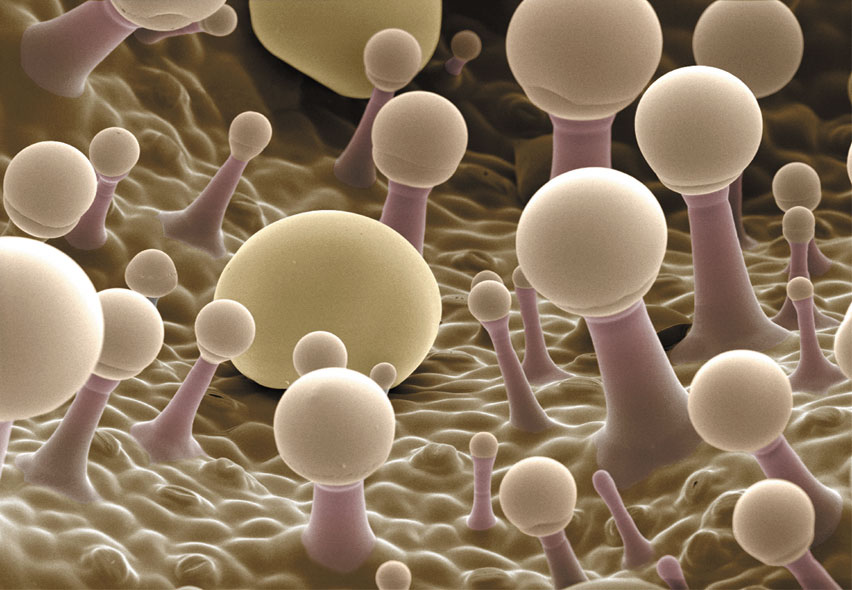The chemist might describe essential oils as chemical compounds generally made up of hydrogen, carbon and oxygen derived from a single botanical species. The manufacturer might say they are volatile materials extracted from plants by means of physical processing. Both definitions are correct, but neither explain the origin of essential oils.
The purest form
Essential oils are often incorrectly referred to as essences, but an essence is an aromatic substance secreted by a plant in its purest form before it has been distilled (by water or steam) and subjected to chemical change. And even then, the term 'essential oil' is applied loosely in aromatherapy, when it should only be used to describe oils extracted by distillation. Oils extracted by solvents or enfleurage are actually absolutes, while oils extracted by pressure remain pure essences.
The Origin of Plant Essences
The origins of plant essences lie with photosynthetic activity in plant cells called chloroplasts, which surround secretory structures. Photosynthesis is the process by which chloroplasts absorb sunlight and convert it to energy stored in the form of glucose. This stored energy is released to allow other chemical reactions to take place, such as the formation of essences from the building blocks of oxygen, hydrogen and carbon.
Secretions
Secretory structures are found on the surface of an aromatic plant or on its tissue and vary between plant families and species.
Some plants have glandular trichomes - modified hairs covering the surface - or epidermal cells, which secrete oils through the cell walls. Others produce volatile oils in large intercellular spaces such as secretory cavities or ducts and there are those that have oil cells, found throughout the the plant tissue.

What are Essential Oils?
So you now know where essential oils come from, but why do plants produce these volatile essences from Sun energy and what is their evolutionary purpose?
Competitors
The volatile oils of one plant can be toxic to another and are used in plant warfare to prevent rival vegetation competing for growth in an already established area.
Like animals, plant species are in competition with each other to secure the best locations for germination and growth in terms of air, light and soil conditions. The weapons they use are the chemical compounds in their oils. This is called allelopathy.
The specific compounds responsible for allelopathy are monoterpenes, which are in the most abundant chemical group of essential oils: terpenes. Monoterpenes of one plant adversely affect the ability of another plant to respire and to produce energy by photosynthesis.
Essential oils also provide other advantages. For example, when they are produced in the leaves they reduce the amount of water lost to the atmopshere.
The Life Blood
It has been said that essential oils are the 'life blood' of plants because they perform many important biological roles.

Most flowering plants rely on pollination insects (such as bees and butterflies) for their survival and they attract pollinators using shape, colour and scent.
Essential oils are responsible for the latter and compounds in plant essences have been found to match those in the odour glands of insects. The production of scent is also increase when a plant is ready for pollination and at the time of day when insects are most active.
Some plants are pollinated by nocturnal animals such as bats and moths and so its important that they produce a very strong scent to attract these pollinators at night time. Bat-pollinated flowers tend to smell like cabbages or fruit and moth-pollinated flowers have a strong, sweet odour.
Self-defence
Certain chemicals in plant essences act as a means of self-defence, protecting the plant from pests, fungi and microbial attack.
Recent research has shown that the chemical group terpenes in essential oils can be toxic to certain mammals and so protect some plants from being nibbled on my herbivores. Examples of plants high in terpenes are wild thyme and marjoram, which are usually avoided by goats in the Mediterranean.
Terpenoid compounds also protect plants from fungi and microbes, while citronella and camphene (active compounds of citronella) deter insects.
The chemical thujone present in some plants, such as wormwood and sage, has a powerful action against parasites. In traditional medicine this chemical is extracted from the essential oils to expel intestinal worms.
Time to Reflect
So now you have a better understanding of the origin of essential oils. By harnessing Sun energy and combining elements from the surrounding environment - the oxygen, hydrogen and carbon in the air, water and soil - plants can manufacture complex, volatile molecules.
You have already been introduced to the eight chemical groupings of these molecules: alcohols, acids, aldehydes, esters, ketones, phenols, sequisterpenes and terpenes (see here). These groups are found in hundreds of different combinations in different plants, and it is the specific combination of these molecules in one plant that lends it and its essential oil unique properties. There can be chemical similarities or vast differences between botanical families.